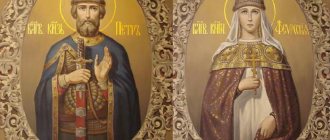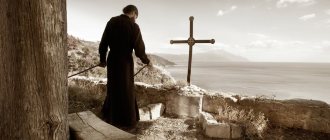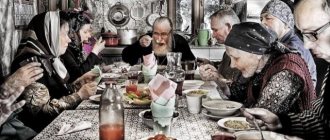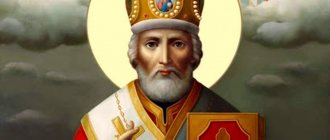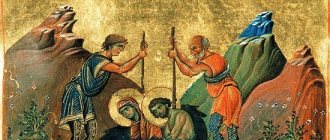Venerable Paraskeva Petka of Serbia
October 26th 2015 —
Memory 14/27 October
Paraskeva of Serbia, Saint Paraskeva, Paraskeva Friday, Tarnovskaya, Bulgarian, Moldavian (Serbian: Sveta Petka; Bulgarian: Petka Bulgarska; 11th century) is a Christian saint, famous for her asceticism. He is revered among the saints.
She was born in the city of Epivat (Επιβάτες, now Selimpasha (English) Russian near Istanbul in Turkey) on the shores of the Sea of Marmara not far from Constantinople.
In addition to their daughter Paraskeva, they had a son. They sent him to school, and his daughter was raised in the house of her pious parents. Paraskeva's brother, when he was sufficiently taught the Holy Scriptures, with the consent of his parents, took monastic vows under the name of Euthymius. Euthymius later became a bishop in Madita, where he became famous for his virtuous life and, during his life and after his death, performed many glorious miracles.
After the death of her parents, Paraskeva distributed the inheritance she received and went to Constantinople, where she lived for five years. There she took monastic vows and went to the Holy Land to worship shrines. After the pilgrimage, she settled as a hermit in the desert in the Jordan Valley and began to lead an equal-angelic life here. Imitating the God-seer, the prophet Elijah and John the Baptist, she ate only desert grains, consuming them only in small quantities, and then only after sunset.
Gradually melting, now from the heat, now from the cold, she turned her gaze only to the One God, who can save the humble in heart and hide from the whirlwind, from the storm (Ps 54:9). Who can tell how many tears the saint shed? Who will tell about her frequent and incessant lamentations? Who will convey in detail about her constant kneeling and various physical feats? Only the All-Seeing God looked at the exploits of the saint. She had no worries there about worldly vanity: she only cared about the purification of the soul, about the answer to the future judgment and the meeting with the Heavenly Bridegroom. “I’m looking for you, my groom!” - said the Monk Paraskeva and constantly kept in mind the saying of the book of Song of Songs: “Tell me whom my soul loves” (Song 1, 16). She cared most about how to decorate her lamp and, together with the wise virgins, go out to meet the Heavenly Bridegroom, hear His sweet voice and enjoy the sight of His beauty. “When will I come and appear before the face of God?” (Ps 41:3) - the saint continually spoke.
When, therefore, the Monk Paraskeva was in the desert, the crafty enemy envied her virtues and tried to frighten her with dreams and ghosts. Repeatedly turning into various animals, he rushed towards the saint in order to create an obstacle for her on the path of her exploits. But the good bride of Christ, Paraskeva, “You have chosen the Most High as your refuge” (Ps. 90:9) and with His help, through the sign of His holy cross, drove away enemies and tore apart, like a web, all the machinations of the devil, and completely overthrew him. The saint, despite her feminine nature, had a truly masculine mind and defeated the devil, like David defeated Goliath. Having adorned her soul with such deeds and virtues, Paraskeva became the beloved bride of Christ, so that the prophetic words were fulfilled on her: “And the King will desire your kindness” (Ps 44:12). So this King dwelt in her with the Father and the Holy Spirit and remained in her as in His holy church, for Saint Paraskeva, having preserved her soul from sin and defilement, became the church of the Living God.
One night, Paraskeva, after a long stay in the desert, as usual, with tenderness stretching out her hands to the sky, stood in prayer. Suddenly, in the form of a bright young man, she saw an angel of God, who, approaching her, said: “Leave the desert and return to your fatherland, for there it is fitting for you to leave your body on earth and go to the Lord with your soul.”
The venerable woman, having penetrated into the meaning of the vision, realized that it reflected God’s command; She rejoiced that the time of her release from the body was near, but she was sorry to part with desert solitude, for nothing purifies the soul and brings it closer to the Prototype than desert and silence. Two years before her death, she returned home in old age.
Arriving in the reigning city of Constantinople, she entered the beautiful temple of the Wisdom of God there, also visited the Blachernae church and, bowing before the miraculous icon of the Mother of God, went to her homeland in Epivatus, where she lived for some time, without changing her usual desert feat - fasting and prayers. When the time came for her departure to God, Paraskeva prayed earnestly for herself and for the whole world, and during prayer she betrayed her blessed soul to God. Her body was buried by believers, according to Christian custom, but not in a common cemetery - like the body of a wanderer who did not tell anyone about herself where she was from.
God, who wanted to glorify his saint, after many years, revealed her relics.
Sermons:
Rev. Paraskeva (The great significance of the Temple of God for Christians). Prot. Grigory Dyachenko
The Life reports that the relics of Paraskeva were miraculously found and placed in a local church, where they became famous for various miracles. In 1238, by order of the Bulgarian Tsar John Asen, they were transferred to the city of Tarnovgrad. After the capture of Bulgaria by the Turks, the relics of Paraskeva were taken to Wallachia, and when it was captured, at the request of the Serbian princess Milica they were allowed to be transferred to Belgrade.
When Suleiman I captured Belgrade in 1521, among other valuables, he took the relics of St. Paraskeva to Constantinople. In 1641, at the request of the Moldavian ruler Vasily, they were allowed to be moved to Iasi, where they remain to this day.
Saint Paraskeva is considered the patroness of Moldavia, since the location of her relics is the city of Iasi, which was the ancient capital of historical Moldavia.
The image of Saint Paraskeva in the lands of the Eastern Slavs closely merged with the ancient cult of pagan Mokosha, to whom women dedicated Friday. Among the people, the saint received the double name Paraskeva-Friday.
The Russian people called Saint Paraskeva - Friday, Pyatina, Petka. The Russified form of the name was popular - Praskovya, reduced. Parasha, Pana.
Paraskeva is considered the patroness of women's winter work, primarily yarn. From this day on, they begin to crumple and fray the flax: “crumple and crush the flax from the dirt.”
The main content of these holidays is the observance of prohibitions on “women’s” work, as well as sacrifices, going to springs, and prayer services.
For Belarusian Catholics and Polishchuks on this day: “you cannot spin, plow, take out ashes and make lye for washing clothes.”
In Polesie there was a special Friday icon: “Friday is such a dark icon. Dull, sad woman sits and prade tow.”
Paraskeva Pyatnitsa was considered a “woman’s saint” - “since our peasant women everywhere consider her their intercessor.” Paraskeva, just like the Virgin Mary on the Intercession, the girls prayed for marriage: “Friday, holy martyr Paraskveya, send me a groom as soon as possible!” (Arkhangelsk province)[2]. Or they could make a slander on the comb: “I will begin to put on the comb, the servant of God (name), and invite suitors to come to me. Just as bees fly to honey and look at flowers, so suitors would hurry to me. In the name of the Father and the Son and the Holy Spirit. Amen". After the slander, the girl wore a comb for seven days in a row[12].
If any knocking was heard in a woman’s closet at night, then the hostess, walking around the corners of the house with a tow or yarn, would kindly and affectionately say:
Noise, noise, what did you realize? Al with joy? Al with sadness? If you are in joy, knock, If you are in grief, be silent! Come yesterday!
In Christianity, several saints bearing the name Paraskeva are revered. In Russian Orthodoxy, the most revered martyr of the 3rd century is Paraskeva-Pyatnitsa (Oct 28/Nov 10). Another saint with the name Paraskeva, called “Petka” in these countries, is popular among Orthodox Christians in Bulgaria and Serbia. In Russia, Saint Petka is called Paraskeva of Serbia or Bulgaria.
Saint Paraskeva was born in the 11th century in the village of Epivat (now located in the European part of Turkey). Even in her youth, her heart, like an arrow, was pierced by the words from the Gospel of Matthew: “Whoever wants to come after me, let him deny himself.” After the death of her parents, Paraskeva began to lead a life full of hardships and sorrows. She hid from the world and settled in the Jordanian desert.
Saint Demetrius of Rostov writes in the life of Saint Paraskeva: “Imitating the God-seer, the prophet Elijah and John the Baptist, she ate only desert grains, consuming them only in small quantities, and then after sunset. Gradually melting away, now from heat, now from cold, she turned her gaze only to the One God, who can save the humble “from cowardice and from the storm” (Ps. 54:9). Who can tell how many tears the saint shed? Who will tell about her frequent and incessant lamentations? Who will tell in detail about her incessant kneeling and various physical exploits? Only the All-Seeing God looked at the exploits of the saint. She had no worries there about worldly vanity: she cared only about the purification of the soul, about the answer to the future judgment and the meeting with the Heavenly Bridegroom. One night, after a long stay in the desert, Paraskeva, as usual, stood in prayer. Suddenly she saw an angel of God in the form of a bright young man, who, approaching her, said: “Leave the desert and return to your fatherland.” No matter how sorry the saint was to part with her deserted solitude, she obeyed the will of God. Having first visited Constantinople and venerated its shrines, Petka returned to her homeland, Epivat, where she lived for some time, without changing her usual desert feat - fasting and prayers. When the time came for her death, Paraskeva, having fervently prayed for herself and for the world, gave up her soul to the Lord. Her body was buried not in the general cemetery, but separately.
The saint's relics were discovered later under miraculous circumstances. Near the place where the saint was buried, a certain stylite labored. It happened that the body of a shipman, who fell ill with a serious illness during the voyage and died, was thrown out there by the waves. A suffocating stench began to emanate from his corpse, which even the stylite could not tolerate. Forced to step down from the pillar, he ordered to dig a hole and bury the stinking corpse in it. When the workers were digging a hole, then, according to Divine vision, they found an incorruptible body lying in the ground. But since the workers were inexperienced and ignorant people, they did not pay any attention to what happened. They reasoned among themselves: “If this body were holy, then God would have revealed it through some miracles.” They again covered the incorrupt body with earth, throwing the stinking corpse there too, and then went home.
As night fell, one of them prayed to God in his house. Having fallen asleep in the morning, he saw in a dream a certain queen sitting on a throne, and around there were many bright warriors. One of them said: “George! Why did you so despise the body of St. Paraskeva and bury the stinking corpse with it? Immediately take the body of the saint and place it in a worthy place, for God wanted to glorify His servant on earth.” Also, that bright queen said to him: “Hurry to take out my relics and put them in a worthy place, because I can no longer tolerate that stench. For I am a man, and my homeland is Epivat, where you also live now.” That same night, a local pious woman had the same vision. In the morning they both told everyone what they saw. Hearing this, pious people went to the relics of St. Paraskeva and with reverence, like some valuable treasure, took them out of the ground. The holy relics were solemnly placed in the church of the village of Epivat, where, through the prayers of Saint Paraskeva, many healings were given to the sick from them. In 1238, the relics of Saint Paraskeva were transferred to the capital city of the Bulgarian land - Ternov (now Tarnovo), and in the 14th century to Wallachia, and then to Belgrade. Since 1641, the relics of Saint Paraskeva have been located in the Romanian city of Iasi.
Action "in itself"
St. Petka’s Day
Worship of St. Petka is an action in itself” (special), because it carries with it the diverse ideas of the Bulgarian hinterland. Since it is directly related to women’s housework, patronage of marriage and family. This Orthodox festival is not without strict control from the church and animal husbandry. Because During this period, fertility and birth rates for farm animals are limited.
Saint Petka's Day symbolizes the beginning of winter, simultaneously with the celebration of this most respected and revered saint among the Bulgarian people.
Traditional dishes - St. Petka's holiday
Despite the fact that the saint lived in the desert, prayed a lot and fasted, the dishes for this holiday are not always Lenten, no, rather the opposite! Three courses include lamb. There is also a special dish that is always served at the table and shared among everyone - Petkova pita. So, a list of six dishes that are prepared for St. Petka’s Day.
1. Soup with lamb.
Ingredients: 1 kg lamb, 2 liters of water, 2 onions, 4 tablespoons of tomato juice, 1 carrot, 1 head of celery, parsley root, salt, black pepper.
2. Petkov bread.
Ingredients: liter of milk, 2 tbsp. spoons of sugar, 2 tbsp. spoons of vegetable oil, yeast, large nut (20g), 2 eggs, 1 kg of flour.
3. Stuffed grape leaves.
Ingredients: 300 grams of chopped sheep meat, 1 cup of rice, 2-3 onions, 200 grams. fat, black pepper, savory, 30 pcs. grape leaves.
4. Lamb stew with leeks.
Products used: 1 kg lamb, 1 kg leeks, 2 tomatoes, salt to taste, 100 gr. vegetable oil, 1 tbsp. a spoonful of dried thyme and 1 teaspoon of black pepper.
5. Salty cake.
Ingredients: 2 cups of kiselo mlyako (Bogarsk yoghurt), slaked with soda, 100 g of butter, 250 g of grated siren, 300 g of flour.
6. Sweet cake on water.
Contents: 5 pcs. eggs, 1 cup sugar, 2 cups (partial) flour, 200 ml water, 100 ml vegetable oil, 1 pack. baking powder, a pinch of vanilla.
How is St. Petka's Day celebrated in Bulgaria?
During St. Petka's Day, in many places in Bulgaria, so-called family services are created, community-wide gatherings, where everyone sits down together for a common meal.
Placed at the same time by clan or neighborhood (“bogovitsa”, “svetets”, Svetaya Petka”).
Our days, holiday Petkovden (St. Petka's Day) in the village of Bistritsa
Women bring and distribute a large loaf - Petkova pita (pie) and wine.
Petkova pita is a special pie or bread, loaf, bun
In this case, the Bulgarian people say that “Sveta Petka brings a holiday.”
Conducting a church service outside the church during St. Petka's Day
Miracles with the relics of St. Petka of Bulgaria
The Life of Petka of Bulgaria says that the saint’s relics were miraculously found and placed in the temple. Where, under their influence, real miracles began to happen to parishioners.
Many miracles are associated with healing from illnesses. The body of a saint is considered incorruptible.
After the occupation and seizure of Bulgarian territory by Turkish troops, the saint’s remains were transported to Wallachia. And when Wallachia was captured, at the request of the Serbian princess Milica they were transported to Belgrade.
From 1641 to this day, the relics have been located in Romania in the city of Iasi.
